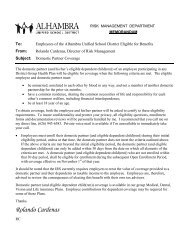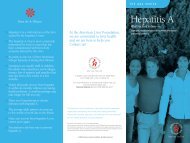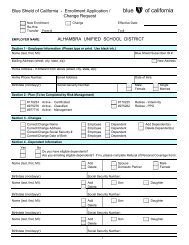Heart Attack, Stroke and Cardiac Arrest Warning Signs
Heart Attack, Stroke and Cardiac Arrest Warning Signs
Heart Attack, Stroke and Cardiac Arrest Warning Signs
You also want an ePaper? Increase the reach of your titles
YUMPU automatically turns print PDFs into web optimized ePapers that Google loves.
<strong>Heart</strong> <strong>Attack</strong>, <strong>Stroke</strong> <strong>and</strong> <strong>Cardiac</strong> <strong>Arrest</strong> <strong>Warning</strong><br />
<strong>Signs</strong><br />
Act in Time<br />
The American <strong>Heart</strong> Association <strong>and</strong> the National <strong>Heart</strong>, Lung, <strong>and</strong> Blood Institute have<br />
launched a new "Act in Time" campaign to increase people's awareness of heart attack <strong>and</strong> the<br />
importance of calling 9-1-1 immediately at the onset of heart attack symptoms.<br />
Dial 9-1-1 Fast<br />
<strong>Heart</strong> attack <strong>and</strong> stroke are life-<strong>and</strong>-death emergencies — every second<br />
counts. If you see or have any of the listed symptoms, immediately call<br />
9-1-1. Not all these signs occur in every heart attack or stroke.<br />
Sometimes they go away <strong>and</strong> return. If some occur, get help fast!<br />
Today heart attack <strong>and</strong> stroke victims can benefit from new<br />
medications <strong>and</strong> treatments unavailable to patients in years past. For<br />
example, clot-busting drugs can stop some heart attacks <strong>and</strong> strokes in<br />
progress, reducing disability <strong>and</strong> saving lives. But to be effective, these<br />
drugs must be given relatively quickly after heart attack or stroke symptoms first appear. So<br />
again, don't delay — get help right away!<br />
Statistics<br />
Coronary heart disease is the No. 1 cause of death in the United States. <strong>Stroke</strong> is the No. 3 cause<br />
of death in the United States <strong>and</strong> a leading cause of serious disability. That's why it's so<br />
important to reduce your risk factors, know the warning signs, <strong>and</strong> know how to respond quickly<br />
<strong>and</strong> properly if warning signs occur.<br />
<strong>Heart</strong> <strong>Attack</strong> <strong>Warning</strong> <strong>Signs</strong><br />
Some heart attacks are sudden <strong>and</strong> intense — the "movie heart attack," where no<br />
one doubts what's happening. But most heart attacks start slowly, with mild pain<br />
or discomfort. Often people affected aren't sure what's wrong <strong>and</strong> wait too long<br />
before getting help. Here are signs that can mean a heart attack is happening:<br />
Chest discomfort. Most heart attacks involve discomfort in the center of the chest that<br />
lasts more than a few minutes, or that goes away <strong>and</strong> comes back. It can feel like<br />
uncomfortable pressure, squeezing, fullness or pain.<br />
Discomfort in other areas of the upper body. Symptoms can include pain or discomfort<br />
in one or both arms, the back, neck, jaw or stomach.<br />
Shortness of breath with or without chest discomfort.<br />
Other signs may include breaking out in a cold sweat, nausea or lightheadedness<br />
As with men, women's most common heart attack symptom is chest pain or discomfort. But<br />
women are somewhat more likely than men to experience some of the other common symptoms,<br />
particularly shortness of breath, nausea/vomiting, <strong>and</strong> back or jaw pain.
Learn the signs, but remember this: Even if you're not sure it's a heart attack, have it checked out<br />
(tell a doctor about your symptoms). Minutes matter! Fast action can save lives — maybe your<br />
own. Don’t wait more than five minutes to call 9-1-1.<br />
Calling 9-1-1 is almost always the fastest way to get lifesaving treatment. Emergency medical<br />
services (EMS) staff can begin treatment when they arrive — up to an hour sooner than if<br />
someone gets to the hospital by car. EMS staff are also trained to revive someone whose heart<br />
has stopped. Patients with chest pain who arrive by ambulance usually receive faster treatment at<br />
the hospital, too. It is best to call EMS for rapid transport to the emergency room.<br />
If you can't access the emergency medical services (EMS), have someone drive you to the<br />
hospital right away. If you're the one having symptoms, don't drive yourself, unless you have<br />
absolutely no other option.<br />
<strong>Stroke</strong> <strong>Warning</strong> <strong>Signs</strong><br />
The American <strong>Stroke</strong> Association says these are the warning signs of stroke:<br />
Sudden numbness or weakness of the face, arm or leg, especially on one side of the<br />
body<br />
Sudden confusion, trouble speaking or underst<strong>and</strong>ing<br />
Sudden trouble seeing in one or both eyes<br />
Sudden trouble walking, dizziness, loss of balance or coordination<br />
Sudden, severe headache with no known cause<br />
If you or someone with you has one or more of these signs, don't delay! Immediately call 9-1-1<br />
or the emergency medical services (EMS) number so an ambulance (ideally with advanced life<br />
support) can be sent for you. Also, check the time so you'll know when the first symptoms<br />
appeared. It's very important to take immediate action. If given within three hours of the start of<br />
symptoms, a clot-busting drug called tissue plasminogen activator (tPA) can reduce long-term<br />
disability for the most common type of stroke. tPA is the only FDA-approved medication for the<br />
treatment of stroke within three hours of stroke symptom onset.<br />
<strong>Cardiac</strong> arrest strikes immediately <strong>and</strong> without warning. Here are the signs:<br />
Sudden loss of responsiveness (no response to tapping on shoulders).<br />
No normal breathing (the victim does not take a normal breath when you tilt the head up<br />
<strong>and</strong> check for at least five seconds).<br />
If these signs of cardiac arrest are present, tell someone to call 9-1-1 <strong>and</strong> get an AED (if one is<br />
available) <strong>and</strong> you begin CPR immediately.
If you are alone with an adult who has these signs of cardiac arrest, call 9-1-1 <strong>and</strong> get an AED (if<br />
one is available) before you begin CPR.<br />
Use an AED as soon as it arrives.






